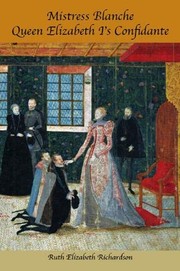Check nearby libraries
Buy this book

It is rare to find totally new information about Queen Elizabeth I but anyone researching her life, King Edward VI, the Tudor Court, women's history, Welsh history or Blanche Parry herself will find this book invaluable.
Blanche Parry was the Chief Gentlewoman of Queen Elizabeth I's Privy Chamber and Keeper of Her Majesty's Jewels but, until now, little more has been accurately known about her or her family. Blanche was born in Herefordshire's Golden Valley to a well connected family and lived until she was 82 years old, a great age at the time. She was constantly with Elizabeth from babyhood until she was 56 years old and so she was at the centre of the Elizabethan Court. Sir William Cecil, Lord Burghley was Blanche's cousin and friend and they worked closely together through the years. Much has been written about the men at Court but very little about the women and yet the evidence shows that everyone at the time recognized Blanche's pre-eminent position. She was discreet, meticulous, trustworthy, elegant, respected and evidently well-liked despite the factional politics. The Queen treated her as a baroness.
There are 9 bardic poems which concern Blanche's family. The bardic tradition was still prevalent in 15th and 16th century Wales with the bards, honoured guests of the lord, providing after-dinner entertainment in the great hall. The poems sung to a harp often had allusions to the family and these families included the Herberts of Raglan Castle, the Stradlings of Saint Donat's and Blanche Parry's own family. The poems give immediacy to the narrative as they describe the claret flowing freely at Blanche's childhood home of Newcourt. For the first time all of these poems, described as revelatory, have been transcribed into modern Welsh, and translated into English by excellent Welsh scholars. They show that Blanche's aunt, Lady Troy was the Lady Mistress for both the young Elizabeth and her brother Edward. The future Queen Mary too was a member of the household run by Lady Troy when she lived with the younger children.
The chapters explore Blanche's family background, her upbringing, education and the religious influences in her life, which included a residual connection with Lollardy. Her family were gentleman of the March of Wales and closely connected with the House of York and with the Herberts of Raglan. One of the bardic poems actually provides a pedigree for her family. Such certainty is very rare and stories of her forebears, fascinating people in their own right, are included. How Blanche arrived at the Royal Court is discussed and her relationship with Elizabeth examined.
When Elizabeth becomes Queen the chapters describe Court life. Here Blanche's particular responsibilities prove to be far more varied than hitherto supposed. We hear about the little musk cat and Elizabeth's quantity of glorious jewels. We also hear about Blanche's role in being a confidante for her mistress and even channelling Parliamentary bills. Evidence is given of people she is known to have helped, their difficulties carefully examined by her and the Queen's wishes carried out. Blanche obtained lands in Herefordshire, Wales and in Yorkshire and these are discussed, the legal cases resulting from some of them, notably Llangorse Lake, being placed in context.
Blanche's death and her monuments are examined for what they can communicate about her life. Her tomb in Saint Margaret's, Westminster portraying her as nearly blind, depicts her elegance and refers to the jewels in her care. By contrast her Bacton monument, with the Epitaph she composed, is a religious statement arranged by Blanche herself. Dated for the very first time, its importance is only now recognised as the first example of Queen Elizabeth being depicted as a religious icon, as Gloriana. The book concludes by looking at Newcourt and at Blanche's legacies, giving full details of her Wills.
The new information is given as accurately as possible with references and it has relevant illustrations. The book places Blanche where she should be - at the very centre of the Elizabethan Court.
Check nearby libraries
Buy this book

Subjects
Elizabethan, Tudor, British History, Women's History, WalesPeople
Elizabeth I, Lord Burghley, Edward VI, John Dee, Whitney, Parry, BlanchePlaces
Westminster, Whitehall, London, Bacton, Dore AbbeyTimes
Late Middle Ages, Tudor, ElizabethanShowing 1 featured edition. View all 1 editions?
| Edition | Availability |
|---|---|
|
1
Mistress Blanche, Queen Elizabeth I's Confidante
2007, Logaston Press, (Logaston Press 2007)
1904396860 9781904396864
|
aaaa
Libraries near you:
WorldCat
|
Book Details
Table of Contents
Edition Notes
ID Numbers
Community Reviews (0)
Feedback?| March 17, 2023 | Edited by ImportBot | import existing book |
| December 18, 2011 | Edited by Ruth Elizabeth Richardson | added tags |
| December 18, 2011 | Edited by Ruth Elizabeth Richardson | reverted to revision 1 |
| December 18, 2011 | Edited by Ruth Elizabeth Richardson | added tags |
| December 15, 2011 | Created by Ruth Elizabeth Richardson | Added new book. |









